통합검색
Acetonitrile 공급부족 해결방법들
Solutions for Acetonitrile shortage - Downsizing 1
Acetonitrile (ACN) is an important solvent for HPLC. Due to the current shortage and increasing prices for ACN there is more interest in conservation and efficient utilization of ACN during chromatography. Changing from ACN to methanol usually changes retention and/or elution order for peaks of interest. A more simple method development approach is to "downsize" the separation by reducing column diameter and length while reducing the particle size of the stationary phase particle. As seen below, such an approach is effective when scaling down within YMC-Pack Pro C18 family of particles because selectivity and peak shape are consistent across all particle sizes. Such "scalability" allows for
dramatic reductions in ACN usage while maintaining selectivity and adequate resolution and increasing the speed (productivity) of analyses.

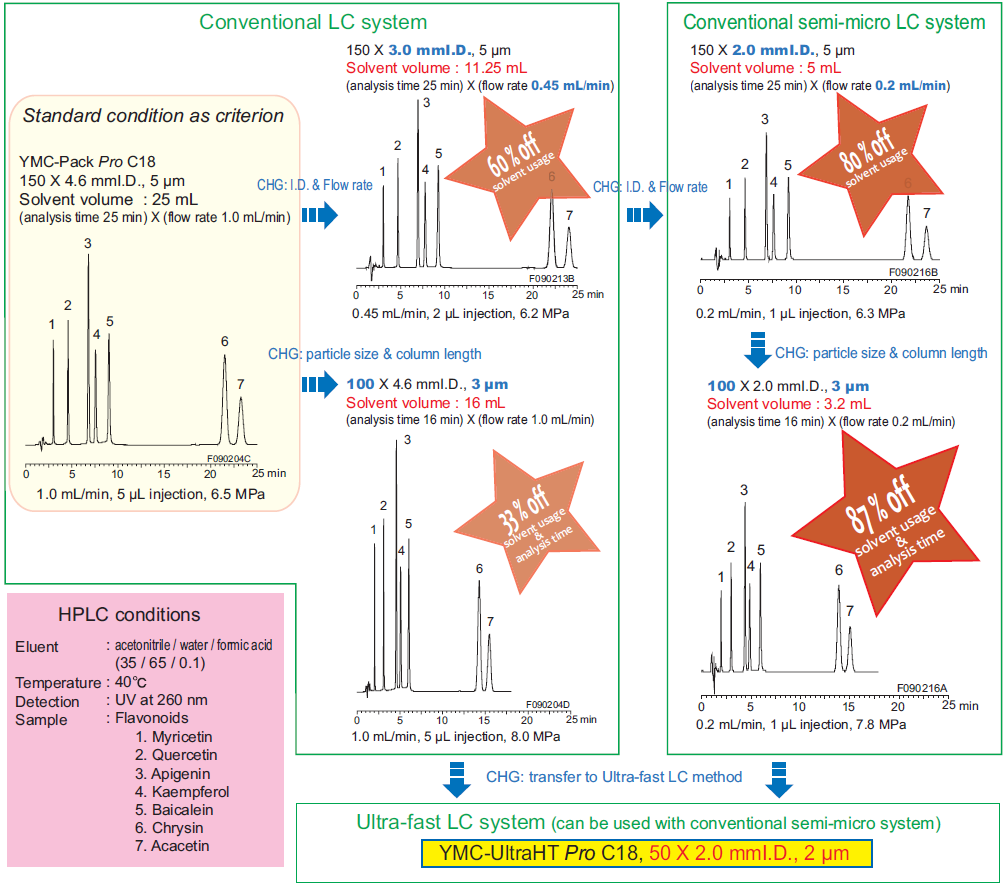
Solutions for Acetonitrile shortage - Downsizing 2
Additional savings on Acetonitrile (ACN) usage can be realized by moving to a 2 micron particle. Moving from a 5 micron, 4.6 x 150 mm column to a 2 micron, 2.0 x 50 mmm column within the YMC-Pack Pro C18 family of particles results in again maintaining selectivity and resolution across particle sizes while allowing for reductions in run time and ACN usage of 90% or better!
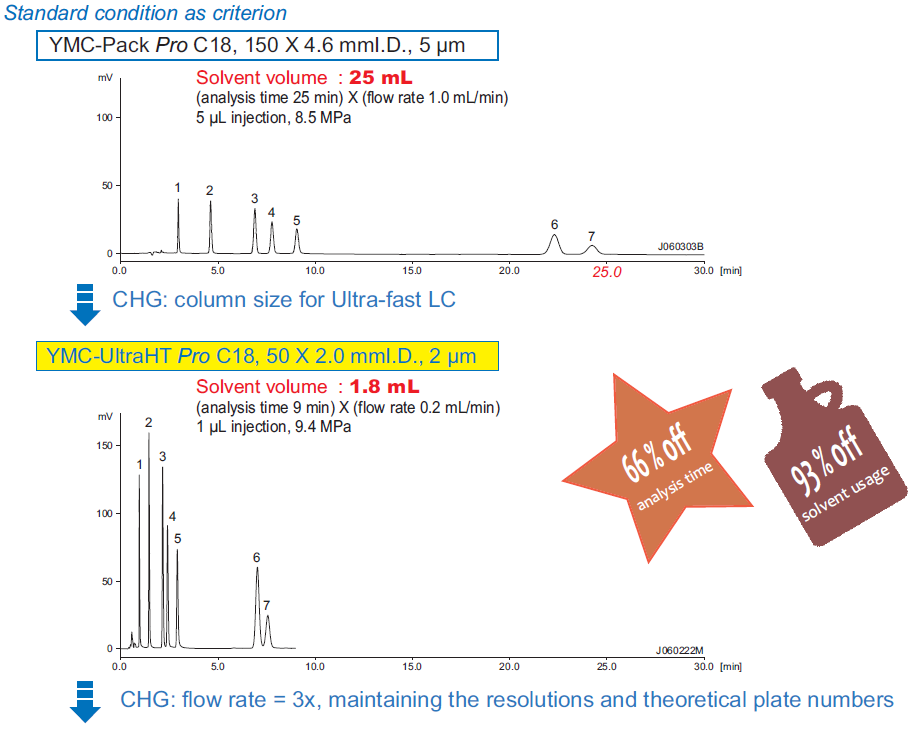
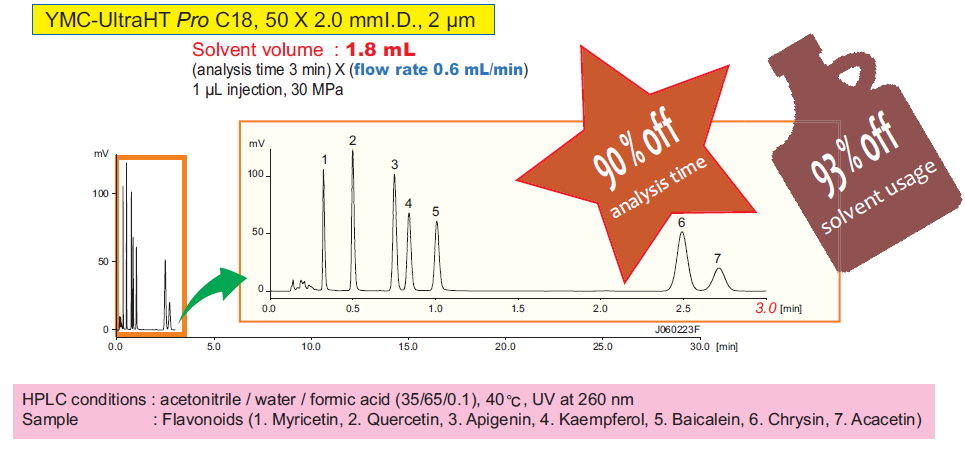
Solutions for Acetonitrile shortage - Solvent modification
The current shortage and increasing price of acetonitrile (ACN) has generated interest in conservation and efficient utilization of ACN during chromatography. In some applications, changing the eluent from ACN to methanol is possible. The separation of flavonoids is just such an example.
Indication for modifying of organic solvents
A table of relative elution power for solvents used in reverse phase chromatography can be viewed as:

The below chart illustrates the correlation between the solvent strength and the mix ratio (on a %v/v basis) of solvents mainly used in reversed-phase chromatography (e.g. 40% ACN = 50% MeOH = 32% THF). ( 1 )

( 1 ) It is not always the case. It is mainly affected by the mix rate of solvent or the solubility of samples. ( 2 ) Due to the compatibility, it cannot be made as AcOEt-aq without additives.
Solvent modification 1 : switch from acetonitrile to methanol
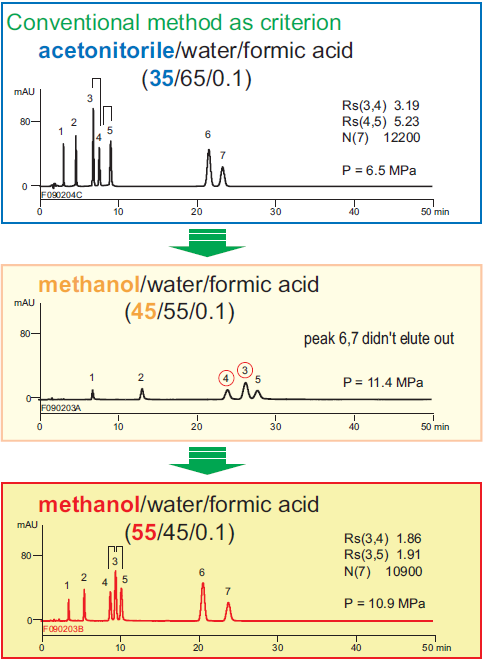 The application to the left is an example of solvent-switch from ACN to MeOH. The flavonoids were analyzed with 45%-
The application to the left is an example of solvent-switch from ACN to MeOH. The flavonoids were analyzed with 45%-
MeOH, switched from 35%-ACN. The elution order of peaks 3 and 4 reversed as is often the case when substituting solvents
in this manner. In addition to the elution order, the retention time and resolution between peaks may be changed when the
eluent is modified in this manner. Thus re-confirmation of each peaks identity is required when changing solvents.
Additionally substituting MeOH for ACN will increase the viscosity of the eluent and the resulting system back pressure
using MeOH will be higher than that of ACN. Reduction of the flow is often necessary to keep the system pressure at
acceptable levels. In this application however, the flow rate was not adjusted. When using 45%-MeOH in this example,
peaks 6 and 7 did not elute even though the column was run for more than 50min. The eluent was then modified in order to
shorten analysis time. The analysis time using 55%-MeOH was about the same time (25min) as the initial method (using ACN). Finally every peak was able to analyzed with baseline resolution.

Solutions for Acetonitrile shortage - Adjustment by additives
Optimizing resolution and/or the analysis time by modifying the solvent from acetonitrile (ACN) to methanol is often a difficult task. Addition of a third solvent might provide the desired results, but method development requires more time and effort. The application below shows how addition of a 3rd solvent (additive) to optimize chromatography as a second step after switching from ACN to methanol can give good results.
Solvent modification 2 : Study of addivites to methanol

The chromatograms seen below are result of modifing the solvent eluent from 50%-methanol to 45%-methanol and 5%-additives.
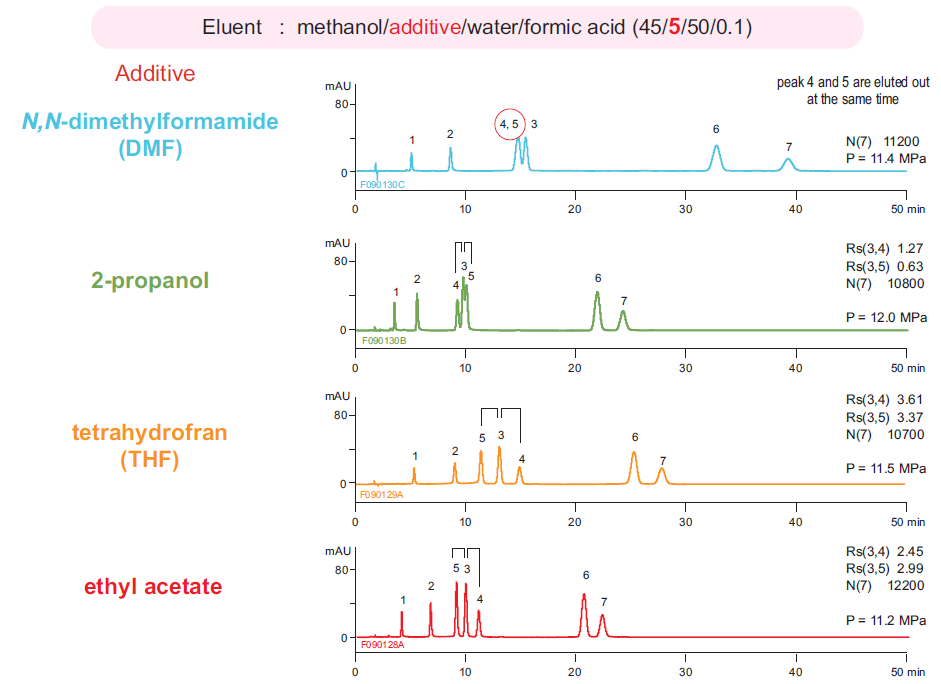

Adding ethyl acetate or THF to methanol is effective in this analysis. Good resolution between peaks and shortened analysis time (productivity increase) are
obtained by substituting equivalent volumes of ethyl acetate or THF for the same volume of methanol.

TERMS OF SERVICE
이용약관제 1조 (목적)
본 약관은 주식회사와이엠씨코리아(이하 와이엠씨코리아)가 제공하는 www.ymckorea.com의 사이트서비스(이하 '서비스')의 이용조건 및 절차에 관해 규정함을 목적으로 합니다.제 2조 (약관의 효력과 변경)
- 1.본 약관에 대한 내용은 회원가입을 위해 이용동의를 누른 회원에게 효력이 발생합니다.
- 2.약관이 변경되었을 시 게시판을 통하여 공지하거나 회원의 이메일을 통한 방법으로 변경 사항을 공지합니다.
- 3.회사는 필요하다고 인정되는 경우 이 약관을 개정할 수 있으며 변경된 약관은 제 2조 2항과 같은 방법으로 효력을 발생합니다.
제 3조 (약관적용 외 내용)
- 1.약관은 당사가 제공하는 서비스에 관한 이용규정 및 별도 약관과 함께 적용됩니다.
- 2.이 약관에 명시되지 않은 사항이 관계법령에 규정되어 있을 경우에는 그 규정에 따릅니다.
제 4조 (용어의 정의)
이 약관에서 사용하는 용어의 정의는 다음과 같습니다.- 1."이용자"란 "와이엠씨코리아 홈페이지"에 접속하여 이 약관에 따라 "와이엠씨코리아 홈페이지"가 제공하는 서비스를 받는 개인회원을 말합니다.
- 2."가입"이란 당사가 제공하는 신청서 양식에 해당 정보를 가입하고, 본 약관에 동의하여 서비스 이용계약을 완료시키는 행위를 말합니다.
- 3."회원"이란 "(주)와이엠씨코리아 홈페이지"에 개인정보를 제공하여 회원 등록을 한 이용자로서 "(주)와이엠씨코리아 홈페이지"의 정보를 지속적으로 제공 받으며 해당 서비스를 계속적으로 이용할 수 있는 자를 말합니다.
- 4."와이엠씨코리아 ID"란 회원식별과 회원의 서비스 이용을 위하여 회원이 신청하고 당사가 승인하는 문자 및 숫자의 조합을 말합니다.
- 5."비밀번호"란 이용자가 회원ID와 일치하는지를 확인하고 통신상의 자신의 비밀보호를 위하여 이용자 자신이 선정한 문자와 숫자의 조합을 말합니다.
- 6."탈퇴"란 회원이 이용계약을 종료 시키는 행위를 말합니다.
- 7.본 약관에서 정의하지 않은 용어는 개별서비스에 대한 별도 약관 및 이용규정에서 정의합니다.
제 5조 (회원 가입 및 자격)
- 1.와이엠씨코리아의 홈페이지 서비스를 사용하는 고객은 와이엠씨코리아가 정한 일정한 회원 가입 절차에 따라 홈페이지를 통하여 개인정보를 입력하여 온라인 회원 자격을 부여 받습니다.
- 2.회사는 새로운 회원이 가입 시 회원 ID를 무료로 제공하며 서비스 이용신청자는 반드시 실명으로 이용신청을 하여야 합니다.
- 3.회원가입은 이용자의 이용신청에 대한 회사의 이용 승낙과 이용자의 약관내용에 대한 동의로 성립됩니다.
- 4.이용자의 회원등록 후 해당하는 조건이 갖추어진 신청자에게는 신청 즉시 온라인상으로 등록사실을 알리는 화면을 보여줍니다. 또한 신청 후 등급 조정을 통해 와이엠씨코리아에서 제공하는 정보를 확인 할 수 있게 됩니다.
제 6조 (회원 탈퇴 및 자격 상실)
- 1.제 5조 1항에 의해 서비스 이용 계약을 맺은 회원이 계약 해지를 원할 경우에는 회원 본인이 직접 회원 탈퇴 신청을 하셔야 합니다.
- 2.다음 각호의 사유에 해당하는 경우 회원자격을 제한 및 정지시킬 수 있습니다.
- 가.타인의 명의를 도용하여 신청하였을 때
- 나.이용 계약 신청서의 내용을 허위로 기재하거나 허위서류를 첨부하여 신청하였을 때
- 다.사회의 안녕이나 혹은 미풍양속을 저해할 목적으로 신청하였을 때
- 라.다른 사람의 당사서비스 이용을 고의로 방해하거나 그 정보를 도용하는 등의 행위를 하였을 때
- 마.당사 사이트를 이용하여 법령과 본 약관이 금지하는 행위를 하는 경우
- 바.기타 당사가 정한 이용신청요건이 미비 되었을 때
제 7조 (개인정보 보호정책)
와이엠씨코리아는 회원이 가입 시 기재한 개인 등록정보 등 정보 보호를 위해 회원의 '개인정보 보호정책'이 정한 바에 의합니다.제 8조 (서비스의 제공 및 이용)
- 1.서비스의 이용은 회사의 업무상 또는 기술상 특별한 지장이 없는 한 연중무휴 1일 24시간을 원칙으로 합니다.
- 2.회사는 다음 각 호에 해당하는 경우 서비스 제공을 중지할 수 있습니다.
- 가.시스템 정비를 위하여 부득이한 경우
- 나.전기통신사업법에 규정된 기간통신사업자가 전기통신 서비스를 중지하는 경우
- 다.천재지변, 국가비상사태 등의 불가항력적인 경우
제 9조 (사용자의 정보 보안)
- 1.가입 신청자가 당사 서비스 가입 절차를 완료하는 순간부터 귀하는 입력한 정보의 비밀을 유지할 책임이 있으며, 회원의 와이엠씨코리아ID와 비밀번호를 사용하여 발생하는 모든 결과에 대한 책임은 회원 본인에게 있습니다.
- 2.와이엠씨코리아ID 와 비밀번호에 관한 모든 관리의 책임은 회원에게 있으며, 회원의 와이엠씨코리아 ID나 비밀번호가 부정하게 사용되었다는 사실을 발견한 경우에는 즉시 당사에 신고하여야 합니다. 신고를 하지 않음으로 인한 모든 책임은 회원 본인에게 있습니다.
- 3.이용자는 당사 서비스의 사용 종료 시 마다 정확히 접속을 종료하도록 해야 하며, 정확히 종료하지 아니함으로써 제3자가 귀하에 관한 정보를 이용하게 되는 등의 결과로 인해 발생하는 손해 및 손실에 대하여 당사는 책임을 부담하지 아니합니다.
제 10조 (정보의 제공 및 광고의 게재)
- 1.회사는 서비스를 운용함에 있어 각종 정보를 웹사이트에 게재하는 방법 등으로 회원에게 제공할 수 있습니다.
- 2.회사는 서비스의 운영과 관련하여 웹사이트, 전자우편 등에 광고 등을 게재할 수 있습니다.
제 11조 (당사에 제출된 게시물의 저작권)
- 1.귀하가 게시한 게시물의 내용에 대한 권리는 귀하에게 있습니다.
- 2.당사는 게시된 내용을 사전 통지 없이 편집, 이동 할 수 있는 권리를 보유하며, 다음의 경우 사전 통지 없이 삭제 할 수 있습니다.
- 가.본 서비스 약관에 위배되거나 상용 또는 불법, 음란, 저속하다고 판단되는 게시물을 게시한 경우
- 나.다른 회원 또는 제 3자를 비방하거나 중상 모략으로 명예를 손상시키는 내용인 경우
- 다.공공질서 및 미풍양속에 위반되는 내용인 경우
- 라.범죄적 행위에 결부된다고 인정되는 내용일 경우
- 마.제3자의 저작권 등 기타 권리를 침해하는 내용인 경우
- 바.탈퇴자가 게시한 게시물
- 사.기타 관계 법령에 위배되는 경우
- 3.귀하의 게시물이 타인의 저작권을 침해함으로써 발생하는 민, 형사상의 책임은 전적으로 귀하가 부담하여야 합니다.
제 12조 (회사의 의무와 책임)
- 1.서비스의 소유 및 운영은 회사에 있습니다.
- 2.회사는 서비스와 관련하여 득한 회원의 개인정보를 본인의 사전 동의 없이 타인에게 누설, 공개 또는 배포할 수 없으며, 서비스 관련 이외의 상업적인 목적으로 사용할 수 없습니다. 다만 관계법령에 의한 경우 및 수사상의 목적 등의 경우는 예외로 합니다.
제 13조 (회원의 의무)
- 1.회원은 관계법령, 이 약관의 규정, 이용안내 및 주의사항 등 회사가 통지하는 사항을 준수하여야 하며, 기타 회사의 업무에 방해되는 행위를 하여서는 안됩니다.
- 2.회원은 서비스를 이용하여 얻은 정보를 회사의 사전 동의 없이 복사, 복제, 변경, 번역, 출판, 방송 기타의 방법으로 사용하거나 이를 타인에게 제공할 수 없습니다.
- 3.회원은 서비스 이용과 관련하여 다음 각 호의 행위를 하여서는 안됩니다.
- 가)다른 회원의 ID를 부정 사용하는 경우
- 나)범죄행위를 목적으로 하거나 기타 범죄행위와 관련된 행위
- 다)선량한 풍속, 기타 사회질서를 해하는 경우
- 라)타인의 명예를 훼손하거나 모욕하는 행위
- 마)당사 홈페이지 서비스를 공의로 방해하는 행위
- 바)당사의 승인을 받지 않은 스팸메일, 정크메일, 행운의 편지, 광고, 판촉물, 피라미드 조직, 돈 벌기 사이트 가입 권유 등의 내용을 메일, 게시, 게재 또는 다른 방법으로 전송하는 행위
- 사)타인의 지적재산권 등의 권리를 침해하는 행위
- 아)해킹행위 또는 컴퓨터바이러스의 유포행위
- 자)폭력, 외설적인 메시지, 동영상, 이미지, 음성 등이 담긴 메시지 전송 도는 게시, 게재하는 행위
- 차)당사 직원 또는 서비스 관리자를 사칭하거나 회원의 명의를 도용하는 모든 행위
- 카)당사 사이트에 게시된 정보의 변경 및 배포 행위
- 타)서비스의 안정적인 운영에 지장을 주거나 줄 우려가 있는 일체의 행위
- 파)기타 관계법령에 위배되는 행위
- 3.귀하의 게시물이 타인의 저작권을 침해함으로써 발생하는 민, 형사상의 책임은 전적으로 귀하가 부담하여야 합니다.
제 14조 (회원 정보의 변경)
- 1.회원은 회원정보의 변경(주소, E-mail Address, 전화번호 등)이 있을 경우 즉시 회사가 운영하는 홈페이지에 통보 및 수정을 하여야 합니다.
- 2.회원의 변경사항에 대한 미통보 및 미수정으로 인한 책임은 전적으로 회원에게 있으며 이는 서비스의 정지 및 해지의 사유가 될 수 있습니다.
제 15조 (게시물 또는 내용물의 삭제)
서비스의 게시물 또는 내용물이 규정에 위반되거나 회사의 소정 게시기간을 초과하는 경우 회사는 사전 통지나 동의 없이 이를 삭제할수 있습니다.제 16조 (계약해지 및 이용제한)
- 1.회원이 이용계약을 해지하고자 할 때에는 본인이 온라인을 통해 해지 신청을 해야 합니다.
- 2.회사는 회원이 다음의 행위를 했을 경우 사전통지 없이 이용계약을 해지하거나 또는 기간을 정해 서비스 이용을 중지할 수 있습니다.
- 가.타인의 서비스 ID 및 비밀번호를 도용한 경우
- 나.타인의 명예를 손상시키거나 불이익을 주는 행위를 한 경우
- 다.공공질서 및 미풍양속에 저해되는 내용을 고의로 유포시킨 경우
- 라.가입한 이름이 실명이 아닌 경우
- 마.같은 사용자가 다른 ID로 이중등록을 한 경우
- 바.서비스 운영을 고의로 방해한 경우
- 사.정보통신설비의 오작동이나 정보 등의 파괴를 유발시키는 컴퓨터 바이러스 프로그램 등을 유포하는 경우
- 아.기타 회사가 정한 이용조건에 위반한 경우
- 3.통지합니다. 다만 회사가 긴급하게 이용정지 필요가 있다고 인정하는 경우에는 그러하지 않습니다. 위의 규정에 의해 이용 제한을 하고자 하는 경우, 회사는 사유, 일시 및 기간을 정해 해당 회원에게 서면 혹은 전화 등으로
- 4.회사는 이용제한 기간 중 그 사유가 해소된 것이 확인된 경우에는 이용제한 조치를 즉시 해제합니다.
- 5.이용제한을 통지 받은 회원이 그에 대해 이의가 있을 때에는 이의신청을 할 수 있습니다.
- 6.회사는 위의 이의 신청에 대해 그 확인을 위한 기간까지 이용정지를 일시 연기할 수 있으며, 그 결과를 이용자에게 통지합니다.
제 17조 (손해배상)
와이엠씨코리아는 무료로 제공되는 홈페이지 서비스와 관련하여 회원에게 어떠한 손해가 발생하더라도 동 손해가 회사의 중대한 과실에 의한 경우를 제와하고 이에 대하여 책임을 부담하지 아니합니다.제 18조 (면책 조항)
- 1.회사는 천재지변 기타 이에 준하는 불가항력으로 인하여 서비스를 제공할 수 없을 경우에는 서비스 제공 중지에 관한 책임을 면합니다.
- 2.회사는 이용자들의 귀책 사유로 인한 서비스 이용의 장애에 대하여 책임을 면합니다.
- 3.회사는 이용자가 서비스를 이용하여 얻은 정보 등으로 인해 입은 손해 등에 대하여는 책임을 면합니다.
- 4.회사는 회사가 제공하는 서비스망을 통해 제공하는 정보의 신뢰도나 정확성에 대하여는 책임을 면합니다.
- 5.회사는 는 이용자가 게시 또는 전송한 자료의 내용에 관하여는 책임을 면합니다.
제 19조 (분쟁의 해결)
와이엠씨코리아와 회원간의 서비스로부터 발생하거나 서비스와 관련하여 발생하는 모든 분쟁 및 본 약관의 해석, 수행, 종결 등과 관련한 최종 판결은 회사 소재지의 관할법원으로 합니다.[ 부칙 ]
- 1.이 약관은 2015년 8월 1일부터 시행합니다.
- 2.본 약관에서 규정되지 아니한 사항에 대해서는 국내법에서 정한 관계 법령 및 상 관행에 따릅니다.

PRIVACY STATEMENT
개인정보취급방침1. 개인정보 수집 항목
- 필수항목 : 성명, 아이디, 비밀번호, 주소, 이메일, 연락처(전화번호, 휴대폰번호)
- 서비스 이용 과정이나 서비스 제공 업무 처리 과정에서 다음과 같은 정보들이 자동으로 생성되어 수집될 수 있습니다 : 서비스 이용기록, 접속 로그, 쿠키, 접속 IP 정보
2. 개인정보의 수집
고객의 개인정보는 자발적으로, 구체적으로 기입할때만 개인정보를 수집하고 있습니다.이용자가 제공한 모든 정보는 하기 목적에 필요한 용도 이외로는 사용되지 않으며 이용 목적이 변경될 시에는 사전 동의를 구할 것입니다.
3. 개인정보의 이용목적
와이엠씨코리아는 수집한 개인정보를 다음의 목적을 위해 활용합니다.이용자가 제공한 모든 정보는 하기 목적에 필요한 용도 이외로는 사용되지 않으며 이용 목적이 변경될 시에는 사전 동의를 구할 것입니다.
- 필수정보 : 홈페이지를 통한 회원제 서비스 제공
4. 개인정보의 보유 및 이용 기간
본사은 개인정보의 수집목적 또는 제공받은 목적이 달성된 때에는 귀하의 개인정보를 지체 없이 파기합니다.- 회원가입을 탈퇴하거나 회원에서 제명된 때
다만, 수집목적 또는 제공받은 목적이 달성된 경우에도 상법 등 법령의 규정에 의하여 보존할 필요성이 있는 경우에는 귀하의 개인정보를 보유할 수 있습니다. - 소비자의 불만 또는 분쟁처리에 관한 기록 : 3년 (전자상거래 등에서의 소비자보호에 관한 법률)
- 신용정보의 수집/처리 및 이용 등에 관한 기록 : 3년 (신용정보의 이용 및 보호에 관한 법률)
- 본인 확인에 관한 기록 : 6개월 (정보통신망 이용촉진 및 정보보호 등에 관한 법률)
- 방문에 관한 기록 : 3개월 (통신비밀보호법)
동의거부시에는 홈페이지 서비스가 일부 제한됩니다.

E-MAIL UNAUTHORIZED COLLECTION DENIED
이메일무단수집거부본 사이트에 게시된 이메일 주소가 전자우편 수집 프로그램이나 그밖의 기술적 장치를 이용하여 무단으로 수집되는 것을 거부하며, 이를 위반시 정보 통신망 범에 의해 형사처벌 됨을 유념하시기 바랍니다.
제 50조 (영리목적의 광고성 정보 전송 제한)
- 1.누구든지 전자적 전송매체를 이용하여 영리목적의 광고성 정보를 전송하려면 그 수신자의 명시적인 사전 동의를 받아야 한다. 다만, 다음 각 호의 어느 하나에 해당하는 경우에는 사전 동의를 받지 아니한다. <개정 2016. 3. 22.>
- ①재화등의 거래관계를 통하여 수신자로부터 직접 연락처를 수집한 자가 대통령령으로 정한 기간 이내에 자신이 처리하고 수신자와 거래한 것과 동종의 재화등에 대한 영리목적의 광고성 정보를 전송하려는 경우
- ②「방문판매 등에 관한 법률」에 따른 전화권유판매자가 육성으로 수신자에게 개인정보의 수집출처를 고지하고 전화권유를 하는 경우
- 2.전자적 전송매체를 이용하여 영리목적의 광고성 정보를 전송하려는 자는 제1항에도 불구하고 수신자가 수신거부의사를 표시하거나 사전 동의를 철회한 경우에는 영리목적의 광고성 정보를 전송하여서는 아니 된다.
- 3.오후 9시부터 그 다음 날 오전 8시까지의 시간에 전자적 전송매체를 이용하여 영리목적의 광고성 정보를 전송하려는 자는 제1항에도 불구하고 그 수신자로부터 별도의 사전 동의를 받아야 한다. 다만, 대통령령으로 정하는 매체의 경우에는 그러하지 아니하다.
- 4.전자적 전송매체를 이용하여 영리목적의 광고성 정보를 전송하는 자는 대통령령으로 정하는 바에 따라 다음 각 호의 사항 등을 광고성 정보에 구체적으로 밝혀야 한다.
- ①전송자의 명칭 및 연락처
- ②수신의 거부 또는 수신동의의 철회 의사표시를 쉽게 할 수 있는 조치 및 방법에 관한 사항
- 5.전자적 전송매체를 이용하여 영리목적의 광고성 정보를 전송하는 자는 다음 각 호의 어느 하나에 해당하는 행위를 하여서는 아니 된다. <개정 2024. 1. 23.>
- ①광고성 정보 수신자의 수신거부 또는 수신동의의 철회를 회피ㆍ방해하는 행위
- ②숫자ㆍ부호 또는 문자를 조합하여 전화번호ㆍ전자우편주소 등 수신자의 연락처를 자동으로 만들어 내는 행위
- ③영리목적의 광고성 정보를 전송할 목적으로 전화번호 또는 전자우편주소를 자동으로 등록하는 행위
- ④광고성 정보 전송자의 신원이나 광고 전송 출처를 감추기 위한 각종 행위
- ⑤영리목적의 광고성 정보를 전송할 목적으로 수신자를 기망하여 회신을 유도하는 각종 행위
- 6.전자적 전송매체를 이용하여 영리목적의 광고성 정보를 전송하는 자는 수신자가 수신거부나 수신동의의 철회를 할 때 발생하는 전화요금 등의 금전적 비용을 수신자가 부담하지 아니하도록 대통령령으로 정하는 바에 따라 필요한 조치를 하여야 한다.
- 7.전자적 전송매체를 이용하여 영리목적의 광고성 정보를 전송하려는 자는 수신자가 제1항 및 제3항에 따른 수신동의, 제2항에 따른 수신거부 또는 수신동의 철회에 관한 의사를 표시할 때에는 해당 수신자에게 대통령령으로 정하는 바에 따라 수신동의, 수신거부 또는 수신동의 철회에 대한 처리 결과를 알려야 한다. <개정 2024. 1. 23.>
- 8.제1항 또는 제3항에 따라 수신동의를 받은 자는 대통령령으로 정하는 바에 따라 정기적으로 광고성 정보 수신자의 수신동의 여부를 확인하여야 한다.
제 74조 (벌칙)
- 1.다음 각 호의 어느 하나에 해당하는 자는 1년 이하의 징역 또는 1천만원 이하의 벌금에 처한다. <개정 2012. 2. 17., 2014. 5. 28.>
- ①제8조제4항을 위반하여 비슷한 표시를 한 제품을 표시ㆍ판매 또는 판매할 목적으로 진열한 자
- ②제44조의7제1항제1호를 위반하여 음란한 부호ㆍ문언ㆍ음향ㆍ화상 또는 영상을 배포ㆍ판매ㆍ임대하거나 공공연하게 전시한 자
- ③제44조의7제1항제3호를 위반하여 공포심이나 불안감을 유발하는 부호ㆍ문언ㆍ음향ㆍ화상 또는 영상을 반복적으로 상대방에게 도달하게 한 자
- ④제50조제5항을 위반하여 조치를 한 자
- ⑤삭제 <2014. 5. 28.>
- ⑥삭제 <2024. 1. 23.>
- ⑦제53조제4항을 위반하여 등록사항의 변경등록 또는 사업의 양도ㆍ양수 또는 합병ㆍ상속의 신고를 하지 아니한 자
- 2.제1항제3호의 죄는 피해자가 구체적으로 밝힌 의사에 반하여 공소를 제기할 수 없다.